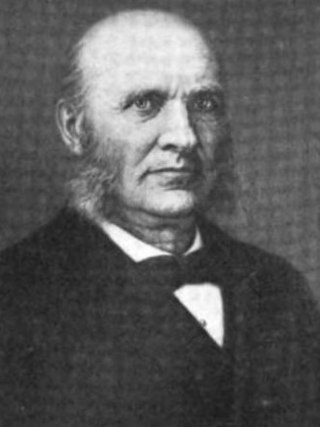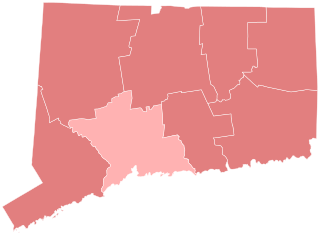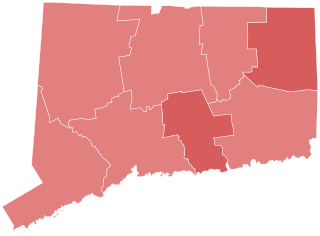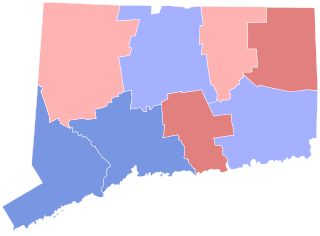
Luzon Buritt Morris was an American lawyer and politician from Connecticut. He served as the 55th governor of Connecticut.
Samuel Edwin Merwin, was an American politician who was the 64th Lieutenant Governor of Connecticut from 1889 to 1893.

Ernest Cady was an American businessman and politician who served as the 65th Lieutenant Governor of Connecticut from 1893 to 1895.

The 1997 New Jersey gubernatorial election was held on November 4, 1997. In the Democratic primary, state senator and Woodbridge Township mayor James McGreevey defeated pre-U.S. Rep. Rob Andrews by 9,993 votes. In the general election, Republican Governor Christine Todd Whitman defeated McGreevey by 26,953 votes. Whitman won 46.87% of the vote, with Democratic nominee James McGreevey receiving 45.82% and Libertarian Murray Sabrin receiving 4.7%.

The 1894 South Dakota gubernatorial election was held on November 6, 1894. Incumbent Republican Governor Charles H. Sheldon ran for re-election to a second term. Despite facing a thread of defeat at the Republican convention, Sheldon was renominated unanimously. In the general election, he faced Populist nominee Isaac Howe, a Spink County Judge; James A. Ward, the former state chairman of the South Dakota Democratic Party; and Prohibition nominee M. D. Alexander. The election was largely a replay of the gubernatorial elections of 1890 and 1892, with the Farmers' Alliance candidate placing second and the Democratic nominee placing a distant third. This time, however, Sheldon won an outright majority and the Democratic Party's vote share shrunk to just 11%, its worst performance in state history.

The 1926 United States Senate election in Connecticut was held on November 2, 1926.

The 1904 Colorado gubernatorial election was held on November 8, 1904.

The 1916 Connecticut gubernatorial election was held on November 7, 1916. Incumbent Republican Marcus H. Holcomb defeated Democratic nominee Morris Beardsley with 51.12% of the vote.

The 1894 Connecticut gubernatorial election was held on November 6, 1894. Republican nominee Owen Vincent Coffin defeated Democratic nominee Ernest Cady with 54.18% of the vote. Coffin defeated Samuel E. Merwin in the Republican primary.

The 1890 Connecticut gubernatorial election was held on November 4, 1890. Democratic nominee Luzon B. Morris defeated Republican nominee Samuel E. Merwin with 50.01% of the vote.

The 1888 Connecticut gubernatorial election was held on November 6, 1888. Republican nominee Morgan Bulkeley defeated Democratic nominee Luzon B. Morris with 47.94% of the vote.

The 1886 Connecticut gubernatorial election was held on November 2, 1886. Republican nominee Phineas C. Lounsbury defeated Democratic nominee Edward S. Cleveland with 46.19% of the vote.

The November 1876 Connecticut gubernatorial election was held on November 7, 1876. Democratic nominee Richard D. Hubbard defeated Republican nominee H. Robinson with 50.84% of the vote.

The 1871 Connecticut gubernatorial election was held on April 3, 1871. It was the fourth consecutive contest between the same two major party nominees. Former governor and Republican nominee Marshall Jewell defeated incumbent governor and Democratic nominee James E. English with 50.05% of the vote.

The 1862 Connecticut gubernatorial election was held on April 7, 1862. It was a rematch of the 1861 Connecticut gubernatorial election. Incumbent governor and Republican nominee William Alfred Buckingham defeated Democratic nominee James Chaffee Loomis with 56.48% of the vote.

The 1857 Connecticut gubernatorial election was held on April 6, 1857. Former Lieutenant Governor and Republican nominee Alexander H. Holley defeated former congressman and Democratic nominee Samuel Ingham with 50.44% of the vote.

The 1856 Connecticut gubernatorial election was held on April 7, 1856. Incumbent governor and American Party nominee William T. Minor defeated former congressman and Democratic nominee Samuel Ingham and former Comptroller of Connecticut and Republican nominee Gideon Welles with 38.99% of the vote.

The 1856 Vermont gubernatorial election for governor of Vermont was held on Tuesday, September 2. In keeping with the "Mountain Rule", incumbent Republican Stephen Royce was not a candidate for a third one-year term. The Republican nomination was won by Ryland Fletcher, the incumbent lieutenant governor. The Democratic nominee was Henry Keyes, a former member of the Vermont House of Representatives and Vermont Senate.

The 1932 Wisconsin gubernatorial election was held on November 8, 1932. Incumbent Republican Governor Philip La Follette was defeated in the Republican primary, and in the midst of the Great Depression and nationwide voter dissatisfaction with the Republican Party, Democratic nominee Albert G. Schmedeman defeated Republican nominee Walter J. Kohler Sr. and Socialist nominee Frank Metcalfe with 52.48% of the vote. Schmedeman became the first Democrat to win a gubernatorial election in Wisconsin since George Wilbur Peck in 1892. Two years later, in 1934, La Follette would run for governor again and defeated Schmedeman, this time running with the Progressive Party.

The 1810 Connecticut gubernatorial election took place on April 9, 1810.























